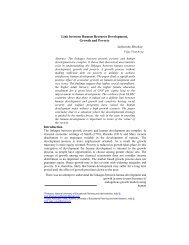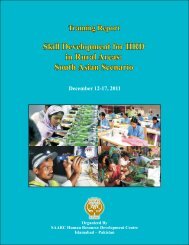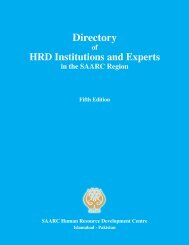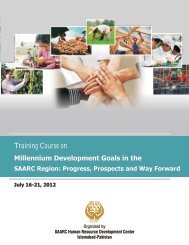Here - SAARC Human Resource Development Centre
Here - SAARC Human Resource Development Centre
Here - SAARC Human Resource Development Centre
You also want an ePaper? Increase the reach of your titles
YUMPU automatically turns print PDFs into web optimized ePapers that Google loves.
Role of HRD in Improving Governance in the <strong>SAARC</strong> RegionSustainable <strong>Development</strong>and Good GovernanceBrigadier Aman UllahDirector General NCRDOctober 5, 2010Meeting the goals ofsustainable developmentA commitment to meet the needs of present and future generations has variousimplications. "Meeting the needs of the present" means satisfying: Economic needs - including access to an adequate livelihood or productive assets;also economic security when unemployed, ill, disabled or otherwise unable to securea livelihood. Social, cultural and health needs - including a shelter which is healthy, safe,affordable and secure, within a neighbourhood with provision for piped water,drainage, transport, health care, education and child development, and protectionfrom environmental hazards. Services must meet the specific needs of children and ofadults responsible for children (mostly women). Achieving this implies a moreequitable distribution of income between nations and, in most cases, within nations. Political needs - including freedom to participate in national and local politics and indecisions regarding management and development of one's home andneighbourhood, within a broader framework which ensures respect for civil andpolitical rights and the implementation of environmental legislation.Meeting Such Needs“Without compromising the ability of future generations to meet their own needs"means: Minimising use or waste of non-renewable resources - including minimising theconsumption of fossil fuels and substituting with renewable sources where feasible.Also, minimising the waste of scarce mineral resources (reduce use, re-use, recycle,reclaim). Sustainable use of renewable resources - including using freshwater, soils andforests in ways that ensure a natural rate of recharge. Keeping within the absorptive capacity of local and global sinks for wastes -including the capacity of rivers to break down biodegradable wastes as well as thecapacity of global environmental systems, such as climate, to absorb greenhousegases.Aim of Sustainable <strong>Development</strong> Improve quality of life. Provide secure income. Develop ways of increasing production without debt. To conserve the environment. To encourage re-use of resources. To develop technology which is appropriate to the skills, wealthand needs for present and future. To optimize the realization of a society many and differentsocial, environmental and economic objectives at one and thesame time.Principles of Good Governance1. Participation – all men and women should have a voice indecision-making, either directly or through legitimate intermediateinstitutions that represent their intention. Such broad participation isbuilt on freedom of association and speech, as well as capacities toparticipate constructively.2. Consensus orientation – good governance mediates differinginterests to reach a broad consensus on what is in the best interest ofthe group and, where possible, on policies and procedures and what isin the best interest of the community.3. It also requires a long term perspective for sustainable humandevelopment and how to achieve the goal of such development.Principles of Good GovernanceContinued ...4. Strategic vision – leaders and the public have a broad and longtermperspective on good governance and human development,along with a sense of what is needed for such development. There isalso an understanding of the historical, cultural and social complexitiesin which that perspective is grounded.5. Responsiveness – institutions and processes try to serve allstakeholders. Effectiveness and efficiency – processes andinstitutions produce results that meet needs while making the bestuse of resources.6. Accountability – decision-makers in government, the privatesector and civil society organizations are accountable to the public,as well as to institutional stakeholders. This accountability differsdepending on the organizations and whether the decision is internal orexternal.37
















